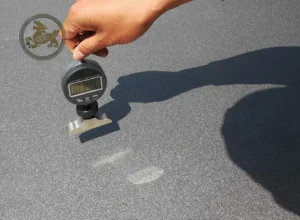Surface preparation standard grades : What is Sa 2.5
Surface preparation standard of abrasive cleaning: SSPC/NACE & ISO 8501 (Sa 2.5)
What does SA 2.5 blasting entail in surface preparation standards?
The ISO 8501 (Sa 2.5) and SSPC/NACE joint standards are the prominent guidelines for abrasive blasting surface preparation. Comparing these standards can be challenging as they largely align in recognizing the same levels of surface cleanliness grades.
The objective of surface preparation standards is to optimize the lifespan of coatings/paints while minimizing cleaning expenses. These standards serve to ensure effective surface preparation, leading to enhanced durability and cost-efficiency in coating applications.
Surface preparation standards grade of ISO 8501: What is Sa 2.5 in Shot blasting:
The ISO 8501 standard, published by the International Standards Organization (ISO) in 1988, combines the Swedish Standard SIS 055900 (1967) and the German Standard DIN 55928. It provides a pictorial representation of different rust grades and corresponding cleanliness levels, accompanied by descriptive text.
In China, the national standard GB8923-88 “Steel surface modification grade and rust removal grade before painting” divides the rust removal grade of shot blasting machines into four levels denoted by the letter “Sa”.
- Sa 1: Mild spray or projectile rust removal (sandblasting or shot blasting). The steel surface should be free from visible grease, dirt, loose oxide scale, rust, paint coating, or other debris.
 Sa 2: Thorough spray or projectile rust removal. The steel surface should be free from visible grease, dirt, oxide scale, rust, and other attachments. Residual traces should be firmly adhered. The projectile dents formed after shot blasting should be evenly distributed, achieving an anti-slip coefficient of 0.35 to 0.45.
Sa 2: Thorough spray or projectile rust removal. The steel surface should be free from visible grease, dirt, oxide scale, rust, and other attachments. Residual traces should be firmly adhered. The projectile dents formed after shot blasting should be evenly distributed, achieving an anti-slip coefficient of 0.35 to 0.45.- Sa 2.5/21/2: Very thorough spray or projectile rust removal, equivalent to Sa 2.5 grade. The steel surface should be free from visible grease, dirt, oxide scale, rust, paint coating, or other attachments. Any remaining traces should only be light spots or strips. The projectile dents formed after shot blasting should be evenly distributed, achieving an anti-slip coefficient of 0.45 to 0.5.
- Sa 3: Spray or projectile rust removal to achieve a clean steel surface. There should be no visible grease, dirt, oxide scale, rust, paint, or other attachments. The surface should display a uniform metallic luster.
Surface preparation standards grade of SSPC/NACE joint:
In North America, the initial surface preparation standard was introduced in the 1960s by a Pittsburgh-based group of steelworkers associated with architecture. The SSPC (Society for Steel Painting Structures) developed the SSPC standards, which consist of text descriptions accompanied by visual guides (VIS) featuring photo references. In 2000, SSPC and NACE collaborated on joint standards in preparation for an anticipated merger. These joint standards, numbered in reverse order by increasing surface cleanliness, reflect the combined efforts of both organizations.
What is the ISO standard of Sa 2.5 roughly match with the standards grade of SSPC/NACE joint?
ISO adopted the widely recognized standard as Sa 2 1/2, representing Very Thorough Blasting Cleaning, while SSPC designated it as SP 10 Near White. However, these two versions were not equivalent. Sa 2.5 allowed for stains, streaks, and shadows from rust, mill scale, and coatings to remain on up to 15% of the surface, whereas SP 10 permitted only 5% of such imperfections.

